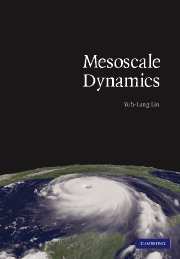Book contents
- Frontmatter
- Contents
- Preface
- 1 Overview
- 2 Governing equations for mesoscale motions
- 3 Basic wave dynamics
- 4 Mesoscale wave generation and maintenance
- 5 Orographically forced flows
- 6 Thermally forced flows
- 7 Mesoscale instabilities
- 8 Isolated convective storms
- 9 Mesoscale convective systems
- 10 Dynamics of fronts and jet streaks
- 11 Dynamics of orographic precipitation
- 12 Basic numerical methods
- 13 Numerical modeling of geophysical fluid systems
- 14 Parameterizations of physical processes
- Appendices
- Index
Preface
Published online by Cambridge University Press: 15 December 2009
- Frontmatter
- Contents
- Preface
- 1 Overview
- 2 Governing equations for mesoscale motions
- 3 Basic wave dynamics
- 4 Mesoscale wave generation and maintenance
- 5 Orographically forced flows
- 6 Thermally forced flows
- 7 Mesoscale instabilities
- 8 Isolated convective storms
- 9 Mesoscale convective systems
- 10 Dynamics of fronts and jet streaks
- 11 Dynamics of orographic precipitation
- 12 Basic numerical methods
- 13 Numerical modeling of geophysical fluid systems
- 14 Parameterizations of physical processes
- Appendices
- Index
Summary
Mesoscale weather systems, such as thunderstorms, mesoscale convective systems, supercells, fronts, jet streaks, gravity waves, severe downslope winds, low-level jets, sea breezes, heat island circulations, and clear air turbulence, are responsible for numerous natural disasters, such as blizzards, torrential rain, flash flooding, damaging winds, and aviation accidents. Thus, a fundamental understanding of their underlying dynamics, the mesoscale dynamics, is essential to help forecast their occurrence. Although textbooks are available in individual subdisciplines such as cloud dynamics, storm dynamics, convection, and synoptic-dynamic meteorology, there are no textbooks which take a systematic approach and cover a more complete spectrum of the mesoscale dynamics. In particular, due to the rapid advancements in research in the past three decades or so, there is a need for a mesoscale dynamics textbook.
The text is presented in four parts: wave dynamics, moist convection, front dynamics, and mesoscale modeling. There are no clear boundaries among these parts. In the opening chapters, the basic equations governing mesoscale weather systems and their approximations are introduced. The wave dynamics include wave generation and maintenance, orographically forced flow, and thermally forced flow. The moist convection part includes mesoscale instabilities, isolated storms, mesoscale convective systems, and orographic precipitation. Traditionally, tropical cyclones are not viewed as a mesoscale phenomenon due to the wide range of scales involved in their genesis, movement, circulations, and convective systems. However, we may also view a hurricane or typhoon as an intense, rotating convective system once it has formed.
Information
- Type
- Chapter
- Information
- Mesoscale Dynamics , pp. xi - xivPublisher: Cambridge University PressPrint publication year: 2007
